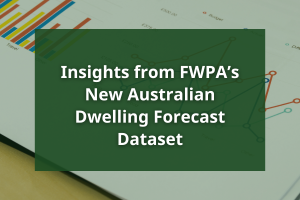Building on 2016’s changes to the Building Code of Australia that saw timber (light weight) and massive timber building systems in the mid-rise space (up to 25m – generally 8 stories) being ‘deemed to comply’, a small number of projects emerged in the 2016-17 financial year.
Built in three states, the new timber buildings may only represent 0.18% of all buildings above four stories commenced in the year, but the evidence is clear that timber is now in the minds of developers, designers and builders.
Mid Rise Market Share Report 2016/17
Background
Prior to 2016 timber construction for buildings higher than 3 stories was permitted only after the designers could demonstrate compliance with the performance criteria specified in the Building Code of Australia (BCA), a lengthy and expensive process. Therefore, to increase the appeal of timber products to architects and developers in this market the FWPA successfully sought to get the BCA amended to permit “fire protected” timber (light weight) and massive timber building systems in the mid-rise space (up to 25m – generally 8 stories). In the project’s supporting documentation, a benefit/cost analysis modelled an uptake rate of 5% per annum over a 10-year period following the BCA amendment. To measure the impact of this change to the BCA and the overall effectiveness of the program, the FWPA has sought to measure the market share of timber products within the mid-rise space for class 2 and class 5 buildings. Below is the second mid-rise market share report following the inaugural report released after the 2015/16 financial year.
Methodology
1) Cordells Direct database was used as the source of information for the east coast market with the focus on the Sydney, Melbourne, Brisbane and Canberra markets.
2) The 4 story and above space is dominated by Concrete or Steel structural elements. Hence to try and determine market share from such a low base a review of all projects rather than a statistical sample was undertaken.
3) The time period under consideration is the 2016-17 financial year and specific projects to be included were:
a. Commencement 1/7/16 to 30/6/17 (this eliminates problem about changing nature of project status at different points of time making a search on building approval potentially confusing as in time it will be replaced by commenced construction etc)
b. Building Type
i. Class 5 Commercial Premises
ii. Class 2 Residential (units, apartments, flats, townhouses, villas, student & group accommodation)
c. Floors 4 and above (although it is important to note that the code change specifically impacts the 4-8 story market)
d. Projects that did not involve a structural component as they were alterations and additions to an existing building were removed from the total project pool (this totalled 6 projects with 5 in 4-8 floor range).
e. Projects that were categorized as both class 5 and class 2 were deemed class 2 in order to avoid double counting.
f. Projects were categorised by structural element as follows:
i. C – concrete
ii. S – steel
iii. T – timber lightweight or massive timber
iv. NSC – No structural element (renovation)
v. C (TMF) – Concrete (Too Many Floors) (default for projects greater than 20 floors)
4) Project analysis
a. An assessment of the project descriptions was undertaken to see if the structural element of the project was defined.
b. For projects where the structural element remained unknown, concrete was allocated
c. Projects that did not involve a structural component i.e. NSC, as they were Alterations and Additions (A&A) to an existing building were removed from the total project pool.
d. 3 interpretations of market share were used
i. Marketshare 1 – number of Timber projects relative to the total number of projects (%)
ii. Marketshare 2 – floor area of timber projects relative to the total floor area of all project (%)
iii. Marketshare 3 – total number of units of timber projects relative total number of units (% – class 2 buildings only)
e. In the event the Cordell project data did not include relevant data such as the number of units or floor area of a project then the average for buildings with a similar number of floors was allocated to create a standardised data set.
Results
Using the above methodology, a total of 568 Projects were identified with 0 timber projects in the 4-8 story space. However, it was discovered that one project – Walert House, Bundoora, was omitted from the previous report and has therefore been included in the most recent results. On top of this 2 timber projects were discovered in the 9+ Story range. The 3 timber buildings discovered were:
4+ Story timber buildings that commenced construction during 2015/16 Financial year
| Project Title | Address | Suburb | Postcode | Council | State | Building Class | Floors |
| AVEO NORWEST – BUILDING A & B – AVEO BELLA VISTA | 28-30 (Lot 701) Norbrik Dr (DP1198639) | BELLA VISTA | 2153 | THE HILLS SHIRE | NSW | 2 | 12 |
| K5 COMMERCIAL BUILDING | 50 King ST | BOWEN HILLS | 4006 | BRISBANE CITY | QLD | 5 | 9 |
| RMIT Student Accommodation Bundoora – Walert House | 345 Mckimmies Road | Bundoora | 3083 | Boroondara | VIC | 2 | 6 |
Total Data Series 4 – 8 story – Mid-Rise BCA deemed to comply (Total projects)
| Timber | Steel | Concrete | Total | |
| Projects | 1 | 15 | 552 | 568 |
| Floor Area | 11000 | 64926 | 2791114 | 286704 |
Conclusion
While the number of mid-rise timber projects was one following the 4 projects recorded in 2015/16. The impact of the changes to the BCA will become clearer in years to come. It is as yet too soon to draw any meaningful inference from this drop in results given the low market penetration of timber to begin with combined with how recently the changes to the BCA came in to effect.
Thom Williams
FWPA
22 January 2018



